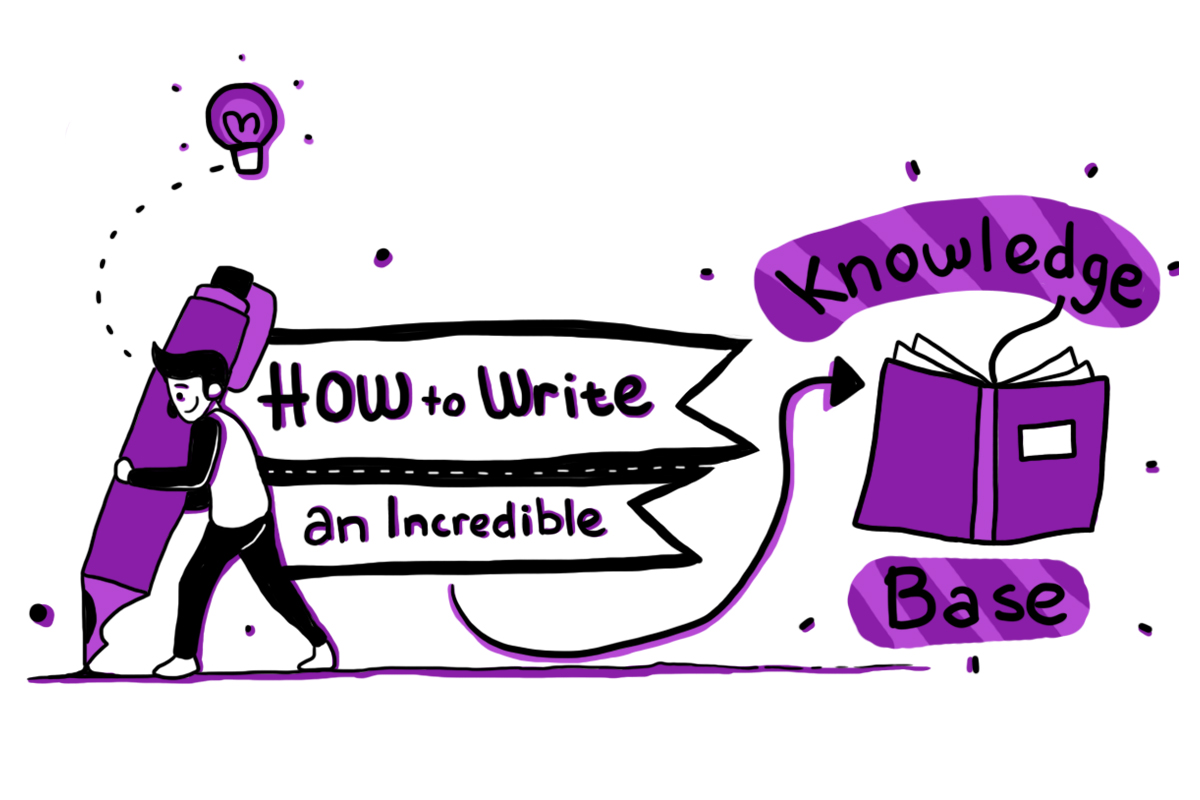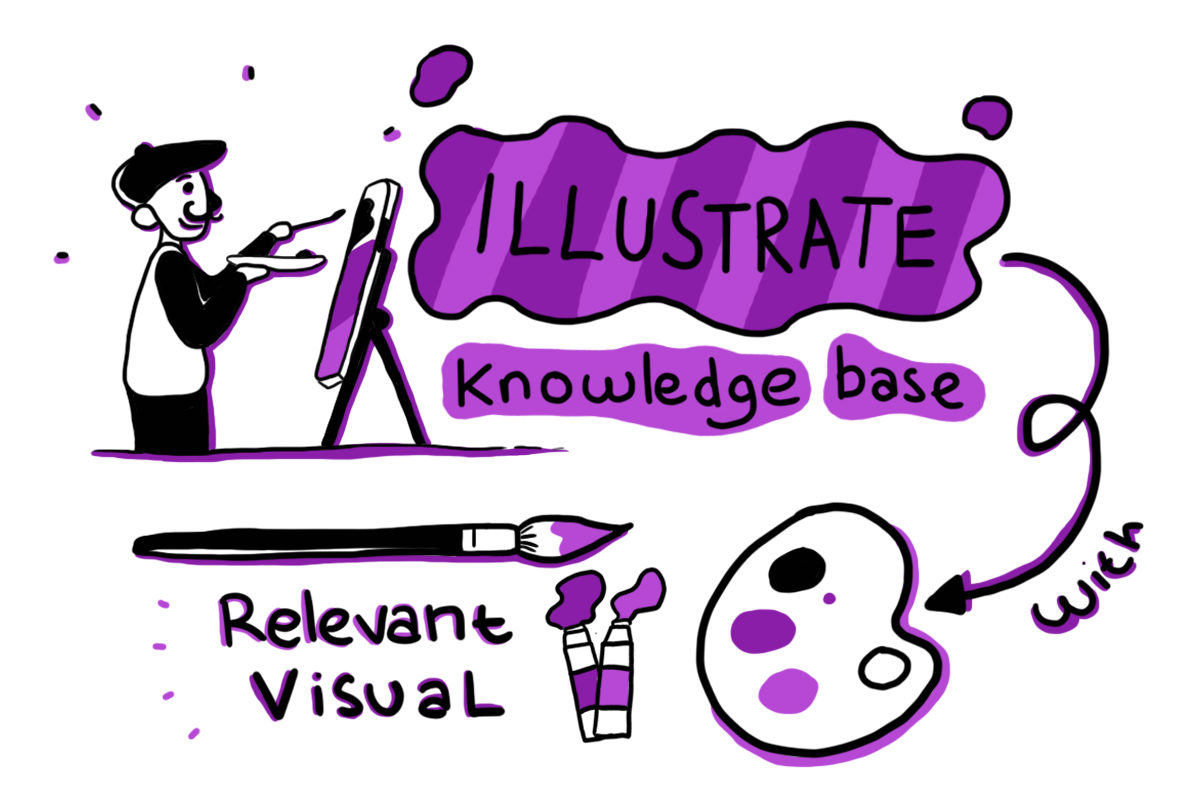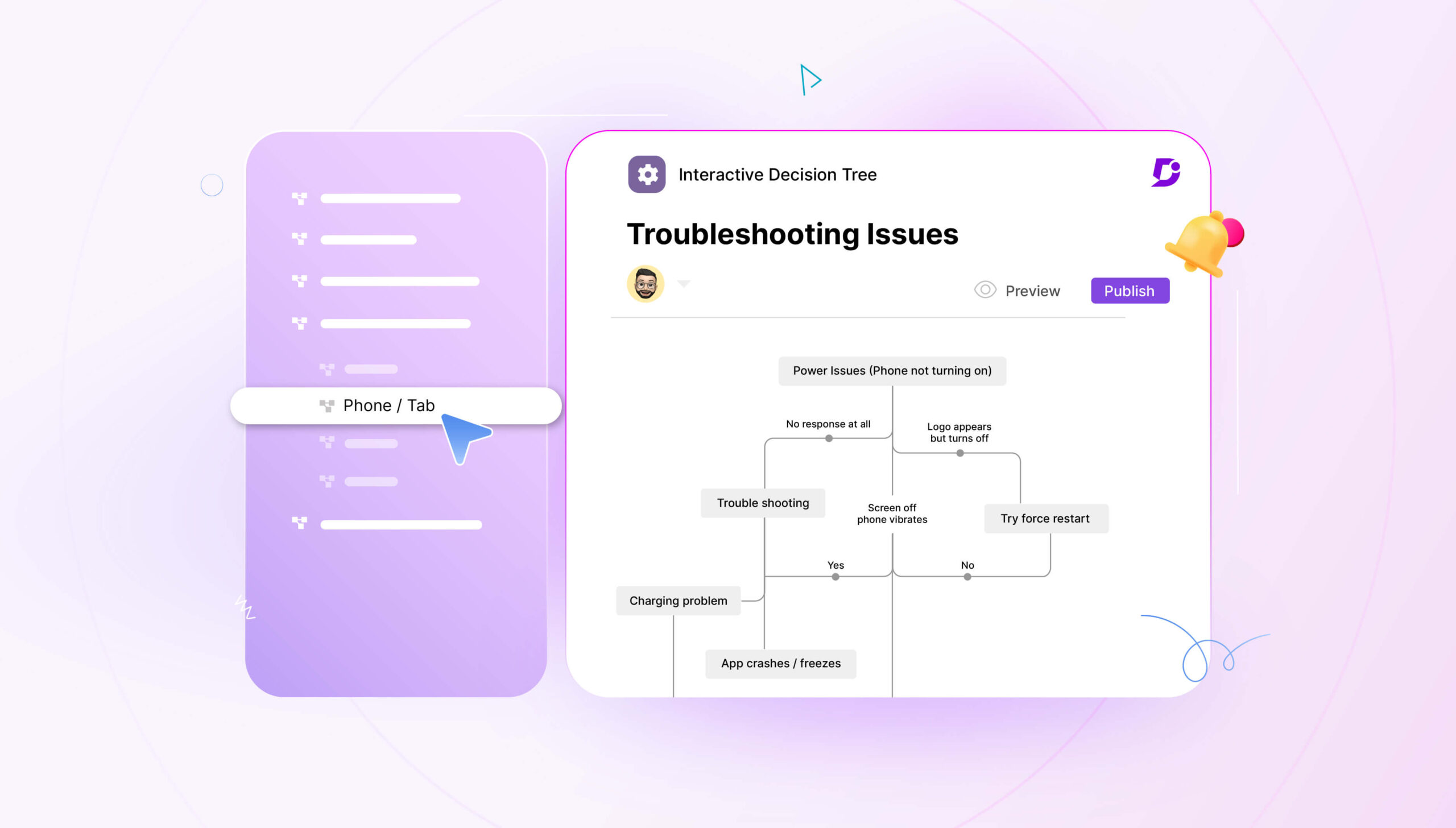The usability of your knowledge base depends on how you organize information and how clear your articles are.
Putting things in the right place is the key to better self-service in customer care. That means you should deliver valuable content, in small chunks, using accessible terminology.

Learning to create helpful knowledge base articles takes time and practice. You need to develop your skills to write content that’s engaging, clear, and informative at the same time.
Every article should be easy to follow, to make things as comfortable as possible for your users, no matter how familiar they are with your product.
Your knowledge base article should also be written in the right tone of voice—professional, but friendly.
The only way to achieve the best results is by mixing a relevant message with sharp writing techniques. And that’s not something you can craft overnight. You need to test your content and improve it on a regular basis.
That’s why we’ve put together the ultimate guide on how to write a knowledge base article to improve customer support.
Before you start writing a knowledge base article
Write a knowledge base article to reflect your objectives: you need to provide your clients with an excellent customer experience on your website, increase traffic, and improve customer retention.
To make things easier, you need a strategy in place. What you do at this stage is vital for how you develop your content.

1. Fundamentals
Define the basics: How your knowledge base fits into your customer support and how you’ll develop it in time.
What topics are you going to cover in your articles?
How to write a knowledge base article better to outshine your competitors?
Defining the scope of your project can help you build a solid foundation for it. As you set a budget and some realistic objectives, you create a picture that gets clearer with every new detail. And, your ideas for quality content become easier.
2. Priorities
Write a knowledge base article with a balanced mix between your expertise and what the audience needs. You must go beyond your competencies and see how to put your knowledge to work.
You’re the expert, but what the customer wants to hear is equally crucial to the success of your knowledge base software.
Implement a knowledge base system today and reduce your customer support cost by 67%
Signup now
When you prioritize, you decide what articles to write first, based on the problems your customers deal with on a regular basis. You choose the topic area that makes a difference for your users, and build content on subjects of interest.
3. Audience
Write a knowledge base article with your public in mind – the people who use your software.
As with marketing, you should build a persona – your average client. This way, you get to know the people you’re really speaking to.
When you write a knowledge base article, remember, you’re talking to a public that already knows you. You don’t have to describe your products. Your mission is to teach your clients how to get the most out of what they purchased.
Build a content plan
Getting ideas for incredible articles is the hardest part of writing. That’s why you need to plan your content ahead. This method helps you to create content on a regular basis and makes sure you cover all the essential topics.
A content plan puts your ideas in order: topics to include and subjects to develop at every step of the project.

How do you know what to start with?
Google can be a helpful guide. Search for the hot topics in the industry and see which results perform the best.
You can also use previous discussions with your clients and tickets you’ve solved in the past, to identify interesting topics for a truly comprehensive knowledge base solution.
Create a different article for every pain point you identify. This way, you’ll give accurate answers to your users, without getting lost in too many details.
Use specific titles
The titles you give your articles should be specific — what question you answer or what problem you solve.
You don’t use your company’s knowledge base to sell, so focus on usability, not drawing attention or hooking new clients.
The title doesn’t have to be eye-catching. It must tell your public what’s in your article. Facebook’s Help Center, for example, uses four types of titles:
- Closed questions: “Can I like or share videos on the Facebook video for TV app?” or “What are my privacy shortcuts?“
- Problems: “I can’t add a video.” or “My privacy settings are not working correctly.“
- How questions: “How do I view my information on Facebook?” or “How do I choose what I get notifications about?“
- Descriptive title (the exact phrase of the process you describe): “Cost per optimization event” or “Friending.“

These titles are optimised, making navigation easy for any user, new or already used to your knowledge base.
There are many more options than these four types of titles. Google Support, for example, has adopted the word “About” for many of the articles in its knowledge base: “About manual CPC bidding“, or “About campaign budgets“.
You can also work with words such as “Setting up“, “Creating“, “Getting started“, or “Using“, depending on your activity.
Here are some examples from MailChimp: “Set Up MailChimp Subscribe for iPad“, “Create a landing page“, or “Use Button Content Blocks“.
The “How to” title can also be a smart choice. It explains what each article is about with minimum words.
Keep intros short
It’s always tricky to craft the perfect introduction, especially when you have to draw attention and to convince the reader to keep reading. But that’s not the case when you write a knowledge base article.
Here, simplicity is key – say things as if you were talking to someone. You don’t have to create intrigue.
Think about what brings the readers to the article in the first place. Do they need to learn more about your product? Are they looking for an easy and quick solution to a problem?
Your readers are going to keep reading because they need answers. Otherwise, they’ll have to call for support. So, make sure you deliver what they need, and no one will notice your intro.
Make your knowledge base easily searchable on the internet
Get started today
The sooner you start talking about the topic, the better. If you need to explain a feature of your product, start your article with what that feature does. Simple as that!
One or two paragraphs are enough to enter into any topic. Just put three to five short sentences together, in which you explain what the article is covering.
Make sure your intro answers fundamental questions:
- What is the article about? — a function, feature, problem
- Who can act? — Premium users, all users, admins
- Where can the users access it? — what devices, what internet connection
- When will the feature be available? (if necessary)
When creating your internal knowledge base, some articles may be short (less than 100 words). In this case, get right into the answer. It helps your customers save time and provides a better experience.
Write step-by-step guides
Most articles in your knowledge base should provide an in-depth answer to “How?”, as they guide your customers through various processes.
Your instructions should be enough to provide your readers with all the details they need to get the most out of your product or fix their problem.
Highlight every step (with numbers, bold text, headings, or subheadings) to make them visible.
Don’t make assumptions. You’re an expert, but your audience has less knowledge on the topic. What seems obvious to you isn’t always self-evident for a new customer.
When you direct your users to a specific page or section, add a link to it. Some users feel more comfortable when you hold their hands a little.
When you furnish your articles with links and helpful details, you provide your customers with everything they need and they won’t have to call for support.
Avoid ambiguity, by being as precise as you can. Give examples to clear doubts, when you feel this could add value to your readers.
Follow the workflow
To write a knowledge base article, start with building a structure. It will help you put your ideas in order.
First, note down the main thoughts, then develop each one with the necessary details.
Organize your article logically – from the first step to the last one, in exact chronological order. And before writing the article, go through the process yourself. This way, you’ll make sure you don’t miss any actions or steps.
If any problem can occur while performing a step, make sure you mention it when you describe the stage. If your customer uses your instructions to get things started, this information will be useful.
When following a sequence isn’t necessary, start with the most simple notions and leave the complicated concepts for the second half of the article.
To make the article easy to follow, break the content into short paragraphs, organised into sections and subsections.
Use lists, bullets, and tables to express your ideas. The fewer words you use, the more comfortable the reading for your customers.
Illustrate your knowledge base article with relevant visuals
People are more likely to remember technical details with coloured images, which increase a reader’s attention by 82 percent.

Adding relevant images when you write a knowledge base article can help you explain notions better. Plus, they save you and your readers a headache.
Using screenshots allows you to show every step, instead of describing them in long paragraphs. Communication becomes faster, more comfortable, and efficient.
Using a screenshot tool, you can capture the right image for every step of the process and back up every instruction with the perfect visual.
To provide clear instructions, you can also add graphic elements to your images, such as directional arrows or circles, to guide your reader’s attention towards the subject of interest.
Place the image after the text that contains the instruction. This approach allows the user to understand the information easier. Placing the image first can create confusion, if the reader doesn’t understand what’s illustrated in it.
Insert videos to improve the user experience
When people can choose between video and text to learn about a product, most of them go for the video.

This type of content can help to create a knowledge base article more engaging and more appealing to your customers.
To make useful videos, you need software for screen capture and editing. And to host your videos, you can use platforms like YouTube, Vimeo, or Loom.
Using videos can help you in optimizing your knowledge base SEO efforts. However, your knowledge base isn’t your business blog. So, use video content only when it allows you to add value to your readers.
Your brand is your identity. Carry your brand identity into your knowledge base
Request a demo
A video is a good fit for tutorials, tips, descriptions of your product’s latest features, summaries of white papers, and other similar complex documentation.
To increase the usability of your knowledge base, complement your videos with a detailed transcription of the visual content. This approach broadens the video’s reach, making it accessible to a wider audience, including non-native speakers and individuals with hearing impairments.
You can also use video to start your topic and continue with written instructions that are easier to follow. It can help users who want to apply in real-time to what they read.
Google uses this approach to provide its users with more information about complex topics.
Videos are less useful when you’re guiding visitors to solve problems and errors. In these situations, your users are looking for quick solutions.
A well-organized text is easy to scan for answers, unlike video, which users need to watch from beginning to end to capture the information they need.
Place the video at the beginning of the article or the top of a new section. If you post it in the middle of a text, you risk distracting your readers and losing their attention.
Create a table of contents for longer articles
There’s no optimal word count for a knowledge base article. From less than 100 words to more than 1,500. The ideal size allows you to cover the topic area from all angles.
As a rule of thumb, the shorter, the better. Too many unnecessary words will make readers lose their patience. They’ll stop reading and call for support to get quick answers.
When the topic requires more words, break the text up to make the article easy to browse. Cut the material into small paragraphs using headings and subheadings.
To facilitate navigation, you could create a Table of Contents. This way, users who don’t need to go through the entire article can jump directly to the part they’re interested in.
MailChimp places a table of contents on the left side of the screen with the title “In this article:“. As you read the article, the table highlights the section you’re currently on. If you want to go back or forth inside the text, you can do so by clicking the specific part in the table of contents.

Include further reading suggestions
Your knowledge base software should be a network of excellent articles that complete each other. This way you give your users all the information they need to draw more benefits from using your product.
At the end of each article in your knowledge base, you can include a section for further reading, where you list articles on similar topics. You can name it using “You May Also Like” (Evernote), “Related Links” (Google), “Related Articles” (Facebook Help Centre), or other similar titles.

Providing additional information helps your readers find all the details they need without effort. Plus, you increase the time users spend on your site, which is a good sign for Google, and can help you improve your SEO.
Ask for feedback
An incredible self-service knowledge base article is updated on a regular basis. You need to keep every piece of content in your knowledge base relevant to your public.
The first step to improving articles is getting feedback from your users. So, at the bottom of each article in your knowledge base, ask your audience to evaluate the content.
Popular knowledge bases, like Google Support or Facebook Help Centre, use a straightforward system. They end their articles with a question like “Was this information helpful?“.
Users can choose from two options – Yes and No. It’s quick, comfortable, and efficient.

When your article doesn’t get good ratings, it’s time to make some changes and improve usability.
10 more tips for crafting engaging knowledge base articles
- Keep a conversational tone. Write as you speak, to make sure your readers understand what you say.
- Don’t use advanced terminology. Your knowledge base should be accessible to all your customers, regardless of their educational background or area of expertise. Avoid slang and jargon, as well.
- Check your grammar. Errors and misspelt words draw attention and suggest poor quality content.
- Optimise for targeted keywords. This way, your articles will be easy to find with the Search function.
- Never add sales copy. People who access your knowledge base have already bought your product. Now they’re looking for help and extra information. Fail to give them that, and you’ll lose them instead of selling more.
- Link to other pages when you think another article can provide more details on a topic. This way, people who aren’t in the right place can easily find what they’re looking for.
- When covering significant problems, you can add a FAQs section at the bottom of the article. Here, you can give short answers to possible questions that a user may have after reading the text.
- If you can’t quit on all technical terminology, consider adding a glossary that users can refer to when they don’t understand a term.
- Keep a unique voice in all your articles. When you coordinate an entire team of technical writers, make sure they all respect the same guidelines.
- Use a single term for every concept across all your articles, to avoid confusion. This way, users who read more material to look for answers won’t end up wondering if you’re talking about the same issue.
Final thoughts
Writing an incredible knowledge base article takes effort. You need to express many technical details in easy-to-read content, to make it available for users with basic knowledge in your area of expertise.
By following these guidelines, you can manage to create valuable articles and provide your audience with consistent content, to help them help themselves.
To make your knowledge base article creation easier, you could use a knowledge base software like Document360. Asides from improving the writing process through it’s simplified WYSIWYG markdown editor, it also makes it easier to improve your knowledge base’s information architecture.
Have you ever had trouble creating top-notch knowledge base articles? Did you use any of the above-mentioned practices? Let us know in the comments section below.
Are you ready to get started with your knowledge base? Why not give Document360 a try? With an uncompromised authoring experience, you’ll be writing incredible knowledge base articles in no time.





 –
– 

